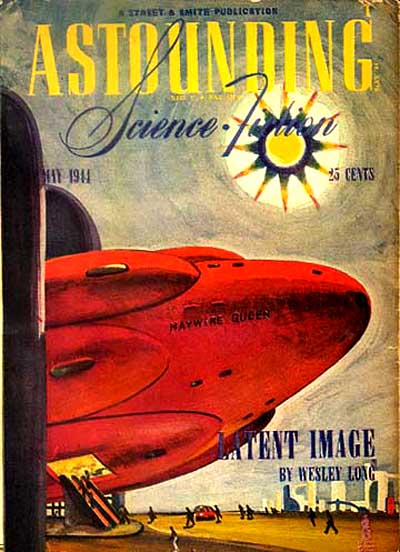 All of us have at least one author who does it for us. Their themes, their writing style, the personality – however distorted – that seeps through their words touches something inside us, resonates with us, makes us feel that we have a friend, someone who may not know us, but nevertheless seems to know us.
All of us have at least one author who does it for us. Their themes, their writing style, the personality – however distorted – that seeps through their words touches something inside us, resonates with us, makes us feel that we have a friend, someone who may not know us, but nevertheless seems to know us.
 My first such obsession was Robert A. Heinlein. I picked up a copy of Starman Jones from the bookmobile while in elementary school. For a year or so I thought he was the only person in the entire world who wrote the kind of thing that he wrote. I quickly caught up with what had gone before and then, like everyone else, had to sit around and wait for the old man to finish writing something new.
My first such obsession was Robert A. Heinlein. I picked up a copy of Starman Jones from the bookmobile while in elementary school. For a year or so I thought he was the only person in the entire world who wrote the kind of thing that he wrote. I quickly caught up with what had gone before and then, like everyone else, had to sit around and wait for the old man to finish writing something new.
In the meantime I discovered that RAH wrote science fiction (wow, they had a whole category for this stuff!). My local bookstore was just beginning to transition from shelving SF under Fiction to giving it its own section and there were several intriguing looking books stacked with the Heinleins. One was by someone named Le Guin (Planet of Exile) and another was this really great deal, two books in one. It even had two cover illos, one for a story by someone named Bradley (The Door Through Space) and the other for a story by someone named Chandler (Rendezvous On A Lost World).
 (In this age of pushing diversity I hasten to note that my first four exposures to SF were equally divided between male and female authors. I can’t take credit as this was not deliberate. But I think it does say something about the power of cover illustrations to draw our attention irrespective of title, author or anything else. I think it also says something about shelving SF as a body, rather than attempting to sub-divide into different ‘punks’.)
(In this age of pushing diversity I hasten to note that my first four exposures to SF were equally divided between male and female authors. I can’t take credit as this was not deliberate. But I think it does say something about the power of cover illustrations to draw our attention irrespective of title, author or anything else. I think it also says something about shelving SF as a body, rather than attempting to sub-divide into different ‘punks’.)
 While I enjoyed Le Guin and Bradley (and have sought out other works by these two fine authors), something about Chandler really goosed my imagination. There was something very realistic and work-a-day about the fictional universe he’d created, something about the way he wrote and the subject of his story that made it more believable and real for me.
While I enjoyed Le Guin and Bradley (and have sought out other works by these two fine authors), something about Chandler really goosed my imagination. There was something very realistic and work-a-day about the fictional universe he’d created, something about the way he wrote and the subject of his story that made it more believable and real for me.
I soon discovered that A. Bertram Chandler was an Australian by adoption (formerly of the UK), that he’d been writing science fiction since 1944 (which wasn’t all that long ago for my 1960s self) and that he’d written a lot. A LOT. Most of it taking place in a coherent and well-thought-out future history and mostly concerning the antics, trials and tribulations of one John Grimes, self-described Horatio Hornblower of Space (that promo phrase has since been co-opted by another famous SF character, one who owes more than a little of her origin to Grimes).
 I also eventually learned that in real life, Chandler was Captain Chandler, a merchant marine plying the seas of the southern Pacific. He saw duty during World War II and, being a science fiction fan himself would stop in at the Astounding editorial offices whenever he found himself in New York. During one such visit, Campbell suggested he try his hand at writing. The results were This Means War, published in the May 1944 issue of Astounding.
I also eventually learned that in real life, Chandler was Captain Chandler, a merchant marine plying the seas of the southern Pacific. He saw duty during World War II and, being a science fiction fan himself would stop in at the Astounding editorial offices whenever he found himself in New York. During one such visit, Campbell suggested he try his hand at writing. The results were This Means War, published in the May 1944 issue of Astounding.
Chandler’s stories were popular, frequently taking second place in Astounding’s Analytical Library feature (drawn from letters to the magazine); he was well-liked and popular enough to be the Guest of Honor at Chicon IV, the 40th Worldcon and Australian fandom has named a special award, presented with the Ditmars, after him, given for Outstanding Achievement in Australian Science Fiction. Chandler received several Ditmars himself and his story Giant Killer was nominated for a Retro Hugo award.
 Two of his stories, the previously mentioned Giant Killer and another, The Cage, are among the most anthologized short stories in the genre. The latter is one of the first (if not the first) humans in an alien zoo stories. Giant Killer is an excellent example of meeting Campbell’s requirement to create aliens that can think as good as a man, but not like a man.
Two of his stories, the previously mentioned Giant Killer and another, The Cage, are among the most anthologized short stories in the genre. The latter is one of the first (if not the first) humans in an alien zoo stories. Giant Killer is an excellent example of meeting Campbell’s requirement to create aliens that can think as good as a man, but not like a man.
Between 1944 and 1984 (Chandler was found dead at his home) Captain Chandler turned out 36 novels, 210 shorts and numerous collections (many of them appearing after his death). He wrote some poetry and frequently contributed to fanzines of the day. That he was a Trufan and not just a filthy pro is revealed in his fondness for puns and Feghoots (several of which were published in professional markets; Fall of Knight and Navel Engagement the most reprinted examples). He sold to most of the US and UK markets, frequently appeared in translation and is still going strong to this day, being particularly popular in Japan. Baen has collected the John Grimes stories (though they are still missing one) in both electronic and trade paperback editions and Audible is now offering many of his works in audio. (If you want to read them in their internal, historical order, you can take a look at this resource).
You can read Giant Killer online (though it shouldn’t be there as Chandler’s stories are not in the public domain) Likewise for The Cage.
But back to Rendezvous and my first encounter with Captain Chandler. Here was a story that incorporated not one but two different FTL drives, the newer, more reliable Mannschenn Drive and the older, more risky Ehrenhaft Drive. The latter often failed. If the crew and passengers were lucky, they might be able to reach a habitable planet and set up a lost colony. Way cool. Humans cut-off from the mainstream for generations. You might find anything awaiting you.
 Rendezvous also hinted at other things. There was mention of a place called the Rim, inhabited planets on the edge of the galaxy, the spiral of the milky-way dominating one half of the sky, the featureless black void of intergalactic space the other half. (The next time you are by an ocean’s shore, go out to the beach at night and stare across the ocean to the horizon. Now imagine the lenticular lens of the galaxy sprawled across that sky.)
Rendezvous also hinted at other things. There was mention of a place called the Rim, inhabited planets on the edge of the galaxy, the spiral of the milky-way dominating one half of the sky, the featureless black void of intergalactic space the other half. (The next time you are by an ocean’s shore, go out to the beach at night and stare across the ocean to the horizon. Now imagine the lenticular lens of the galaxy sprawled across that sky.)
The story itself involves a crew of misfits and ne’r do wells who use a bounty to purchase and repair an older Ehrenhaft drive ship in order to seek their fortunes along the interstellar shipping lanes. Along the way we encounter a planet dominated by a cybernetic intelligence whose humanoid robots would give the Cylons of Battlestar Galactica a run for their money, a space pirate gone to pot and the interpersonal relationships of a bunch of misfits cooped up in a tin can for far too long.
Chandler’s greatest contribution to the genre is the utter believability of his ships and their crews. Intentionally modeled upon his own everyday experiences at sea, his stories can’t help but suspend any last ounce of disbelief one may have.
After reading Rendezvous On A Lost World, I added Chandler to my list of rapidly expanding must-read authors. I was fortunate in that ACE kept a number of his novels in print and DAW soon took over, publishing what seemed to be a nearly endless stream of Rim Worlds novels. Almost all of which featured Chandler’s seminal character, John Grimes.

 Now here is revealed the depth of my obsession. A couple of decades ago (or perhaps a bit more) I decided that I liked the Grimes/Rim Worlds stories so much (and there was little chance that any more would be forth-coming) that it would be possible to collect them all, which I set out to do. I obtained a copy of the Galactic Central Press bibliography – Master Mariner Of Space by Gordon Benson, found a couple of online resources and discovered that Ebay was my friend when it came to purchasing pulp magazines. Many of Chandler’s short stories’ only appearance was in their original pulp magazine publication. The Chandler section of the library now consists of quite a number of issues of Super Science, Science Fantasy, F&SF, Galaxy, New Worlds…as well as specialty publications including the NESFA Press special edition Up To The Sky In Ships and Dreamstone Press’ (Aus.) commemorative volume From Sea To Shining Star (a must-have for Chandler fans as it contains a couple of stories not published anywhere else).
Now here is revealed the depth of my obsession. A couple of decades ago (or perhaps a bit more) I decided that I liked the Grimes/Rim Worlds stories so much (and there was little chance that any more would be forth-coming) that it would be possible to collect them all, which I set out to do. I obtained a copy of the Galactic Central Press bibliography – Master Mariner Of Space by Gordon Benson, found a couple of online resources and discovered that Ebay was my friend when it came to purchasing pulp magazines. Many of Chandler’s short stories’ only appearance was in their original pulp magazine publication. The Chandler section of the library now consists of quite a number of issues of Super Science, Science Fantasy, F&SF, Galaxy, New Worlds…as well as specialty publications including the NESFA Press special edition Up To The Sky In Ships and Dreamstone Press’ (Aus.) commemorative volume From Sea To Shining Star (a must-have for Chandler fans as it contains a couple of stories not published anywhere else).
I’ve now collected and read every single last A. Bertram Chandler offering. Multiple times. I’ve identified several stories in the Rim Worlds canon that were previously over-looked. I’ve helped to get Chandler’s second-to-last unpublished story published in Jack Dann’s anthology of Australian science fiction Dreaming Again (a Grimes story titled Grimes and the Gaijin Daimyo – an alternate history/parallel worlds tale) and I’ve rediscovered a lost story – Another Redskin Bit the Dust – as having been folded into the fix-up novel The Far Traveler, another Grimes tale. (The evidence is very strong.)
I’ve failed so far to get a hold of or learn anything at all about Chandler’s last unpublished story, one written on request for Harlan Ellison’s Last Dangerous Visions. Mr. Ellison – as is his right – has so far refused all of my entreaties and requests to read the story True Believers. I’ve brow-beat just about everyone who might know anything about that story (with the exception of Harlan of course) and failed to find out anything about it. The time frame and title leave an open question as to whether it is a Rim Worlds story or not.
Not so obsessional? I’ve not finished yet.
I decided that I wanted to create a Rim Worlds concordance, a compilation of all of the characters, planets, ships, alien races, interstellar empires, drugs, foods, beverages, robots, cliches., clothing, weapons and other technologies present in the Rim. I’m now about a third of the way through that project with some fourteen thousand records in the database. (It’s currently in abeyance in favor of another project you might be familiar with – Amazing Stories.)
Of course, in order to put a concordance together I needed to identify all of the Rim Worlds stories and put them in their proper order. Despite the fact that Chandler didn’t deliberately set out to create a future history, he was nevertheless very consistent in maintaining the internal history of his characters and the window-dressing that populates the background of these stories. (For example, certain historical events – Derek Calver’s rescue of the Trans-Galactic Clippers cruise ship Thermopylae, the disappearance of several people aboard the mystery ship Gift Horse – are referenced on numerous occasions in both Grimes and non-Grimes Rim Worlds stories) Very consistent, but not entirely consistent.
There are several series of stories, usually featuring different main characters, that at first glance would seem to be relatively unconnected – unless one is obsessional and really dives into the details. The series are the Derek Calver stories (The Rim Of Space, The Ship From Outside), the Ex-Empress Irene series (The Empress of Outer Space, Space Mercenaries, Nebula Alert and the Grimes novel The Dark Dimensions); the Christopher Wilkinson series (The Coils Of Time and The Alternate Martians) and the George Whitley/Peter Quinn tales (The Pied Potter, The Deep Reaches Of Space, others), and of course the John Grimes stories.
One of Chandler’s primary themes was that of alternate/parallel universes. His various characters frequently find themselves cast into alternate realms via dreams, drugs, technology (human and alien) or accident. Chandler himself, both as himself and as his science fiction writing alter-ego George Whitley are encountered in several stories (twice Chandler meets Grimes). It shouldn’t be all that surprising then to learn that many of those seemingly disconnected Rim Worlds stories lose most – if not all – of their contradictions if we make the single assumption that they are themselves taking place in an alternate universe. One that shares the general history of the progression of events.
I’ve since identified 31 different universes connected to each other in one fashion or another. Naturally these have been incorporated into a spreadsheet that displays the historical record (as represented by the various stories) cross-indexed by the particular universe the story occurs in. Notice is of course taken of those stories that take place in two – or more – different universes. Those 31 parallel universes include our own since, as was mentioned earlier, Grimes pays a visit to Chandler – our Chandler – in the well-known short The Kinsolving’s Planet Irregulars (also known as Hall of Fame).

An earlier version of the Rim Worlds Alternate Universes Grid can be viewed here Note that it only shows 26 universes; I’ve since added more and am now building the grid in a spreadsheet. (If anyone knows of a way to display an expandable spreadsheet online, I’m all ears.)
Support for this approach is largely internally consistent within the works themselves: there are no historical contradictions so long as one orders the stories correctly. In other words, some stories sharing characters, places and trappings would be contradictory if not for the addition of the parallel universes. For example: some Grimes tales include inertial drive technology while others do not. Its presence or absence is entirely inconsistent even when the internal history is followed. Everything straightens out (nicely) if one presumes two parallel universes and two John Grimes characters, one experiencing history in a universe in which the inertial drive is developed, the other in one in which it hasn’t been developed.
And so it goes throughout the stories. The Ex-Empress Irene stories would be seen as merely sharing the same background and trappings as the Grimes tales, were it not for what takes place in Nebula Alert and in The Dark Dimensions. Nebula Alert features the ex-Empress Irene Trafford and her husband. The Dark Dimensions Grimes. In both stories, characters visit each other’s universes. The earlier events taking place in Nebula Alert are referenced in The Dark Dimensions – which also incorporates Poul Anderson’s Sir Dominic Flandry – borrowed from another author’s “parallel” universe.
 And then you add to all of this the fact that Chandler was one of the first SF authors to break the sex barrier (Grimes is a randy old cuss and often surrounded by lusty women of both human and non-human origin) and frequently dealt with issues that would take others authors many years to get around to. Spartan Planet (a Grimes tale) takes on homosexuality and, while Chandler’s treatment of the subject may be a bit dated, he does treat it with respect. The Bitter Pill (Ditmar winner, non-Rim Worlds) takes on old age and enforced euthanasia.
And then you add to all of this the fact that Chandler was one of the first SF authors to break the sex barrier (Grimes is a randy old cuss and often surrounded by lusty women of both human and non-human origin) and frequently dealt with issues that would take others authors many years to get around to. Spartan Planet (a Grimes tale) takes on homosexuality and, while Chandler’s treatment of the subject may be a bit dated, he does treat it with respect. The Bitter Pill (Ditmar winner, non-Rim Worlds) takes on old age and enforced euthanasia.
 I have my favorites: The Inheritors (Grimes) pays conscious homage to Cordwainer Smith and addresses white slavery. Contraband From Other Space (Grimes) takes place in an alternate universe where giant mutated rats dominate the Rim Worlds and keep humans in slavery. Star Loot promotes Grimes to privateering fleet Commodore (and is a re-telling of the Ex-Empress novel Space Mercenaries). The “Grimes and” shorts are fun, humorous romps.
I have my favorites: The Inheritors (Grimes) pays conscious homage to Cordwainer Smith and addresses white slavery. Contraband From Other Space (Grimes) takes place in an alternate universe where giant mutated rats dominate the Rim Worlds and keep humans in slavery. Star Loot promotes Grimes to privateering fleet Commodore (and is a re-telling of the Ex-Empress novel Space Mercenaries). The “Grimes and” shorts are fun, humorous romps.
As time permits I’ll be progressing through the Rim Worlds works here on Amazing. Taking you all along with me is probably obsessional enough.
Rim Worlds resources on the web include BertramChandler.com, the unofficial/official website, Todd Behr’s tribute site and my own Rim Worlds website. Many novels and story collections are frequently sold on Ebay and quite a number of used copies of most of the Grimes novels are available on ABE (and Amazon as well). You can also visit the Chandler Facebook page.










